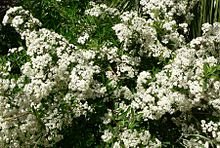Firethorn
| Firethorn | ||||||||||||
|---|---|---|---|---|---|---|---|---|---|---|---|---|

Fruits of the Mediterranean Firethorn ( Pyracantha coccinea ) |
||||||||||||
| Systematics | ||||||||||||
|
||||||||||||
| Scientific name | ||||||||||||
| Pyracantha | ||||||||||||
| M. Roem. |


The fire mandrels ( Pyracantha ) are a genus of evergreen shrubs from the family of the rose family (Rosaceae) and are there to subtribe of maloideae (Pyrinae).
description
Pyracantha species grow as large, evergreen shrubs or small trees, often with heavily thorny branches that usually reach heights of about 4 to 6 meters. The short-stalked to sessile leaves , arranged alternately or in clusters, are simple. The leaf margins are smooth to serrated. There are stipules present.
The umbrella- shaped inflorescences appear in spring or early summer . The hermaphrodite, radially symmetrical flowers are five-fold. The five sepals are mostly green. The five short-nailed petals are white. There are five to 15 stamens with yellow anthers . The five carpels are semi-subordinate. The five styluses are free.
As a genus within the Pyrinae, the fruits look like small apples. The fruits that ripen in autumn are colored yellow, red or orange.
The species of the firethorn genus are originally from Southeast Europe to Southeast Asia. The genus is closely related to Cotoneaster , but differs from it by thorny branches, while Cotoneaster has no thorns.
use
The evergreen firethorn is very popular in gardens as an ornamental shrub because of its striking flowers and berries and is used for hedges because of its thorny branches . Although not indigenous to Central Europe , it is used as a bird protection tree, as its dense growth and thorny branches protect bird nests well from cats , martens and other small predators , and its berries, which remain on the bush for a long time, are eaten by birds in winter. It is quite undemanding and also tolerates drought, which is why it is often used in public green spaces.
The fruits of the European firethorn are not edible for humans, they are considered to be slightly poisonous. It contains small amounts of cyanogenic glycosides ; consumption of the fruit can lead to gastrointestinal problems.
When cooking the fruit to make jam, it is important to ensure that the puree does not contain any seeds. Firethorn jam is a tasty alternative to traditional sea buckthorn jam.
Poisoning, mostly of a minor nature, occurs especially in small children. The leaves of the European firethorn contain rutin and chlorogenic acid , among other things .
Species (selection) and distribution
There are seven to ten species in the genus Pyracantha that are distributed from Southeastern Europe to Southeast Asia . Of the seven species found in China, five are endemic there .
- Pyracantha angustifolia (Franchet) CC cutter : China .
- Pyracantha atalantoides (Hance) Stapf : China.
- Mediterranean Firethorn ( Pyracantha coccinea M. Roemer )
- Pyracantha crenulata (D.Don) M. Roemer : Himalaya .
- Pyracantha densiflora T.T.Yu : China
- Pyracantha fortuneana (Maximowicz) HLLi (Syn .: Photinia fortuneana Maximowicz , Photinia crenatoserrata Hance , Pyracantha crenatoserrata (Hance) Rehder , Pyracantha crenulata var. Yunnanensis M.Vilmorin ex Mottet , Pyracantha gibbsii var. Yunnanensis (M.Vilmorin ex Mottet) A. Osborn , Pyracantha yunnanensis (M.Vilmorin ex Mottet) Chittenden ): China
- Pyracantha inermis Vidal : China
- Pyracantha koidzumii (Hayata) Rehder : Taiwan .
- Pyracantha rogersiana (AB Jacks.) Bean : China.
The forms planted in gardens are listed as varieties and hybrids of Pyracantha coccinea . There are firethorn varieties with yellow, orange and red berries:
Varieties with yellow fruits
- 'Soleil d'Or'
Orange fruit varieties
- 'Golden Charmer'
- 'Orange Glow'
- 'Mohave'
Varieties with red fruits
- 'Red Column'
- 'Coral'
- 'Bad Zwischenahn'
literature
- P. Schütt, HJ Schuck and B. Stimm: Lexicon of tree and shrub species. Nikol-Verlagsgesellschaft mbH, Hamburg, 2002
- L. Roth, M. Daunderer, K. Gormann: Toxic Plants- Plant Poisons , 4th edition, Nikol-Verlagsgesellschaft mbH, Hamburg, 2006
Web links
- Description in the Flora of China. (English)


